The 20 Most Low-Maintenance Pets You Can Own
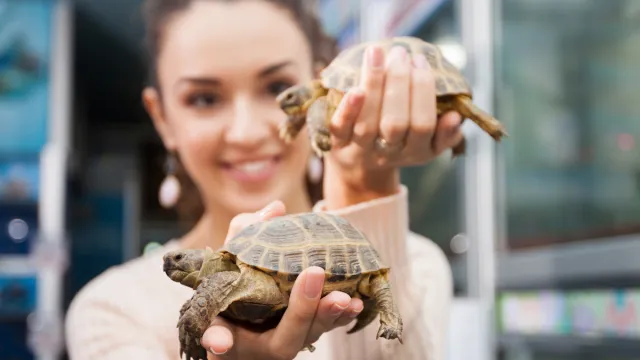
When it comes to welcoming pets into your family, every animal needs to be cared for and loved. However, when you’re a busy person, it’s just not possible to spend every waking moment looking after a rambunctious dog or cuddly cat. That doesn’t mean you don’t deserve to bring an animal into your home—you just have to find the right one. Some pets need less grooming and attention, while many are simply cheaper to own. So whether you’re looking for something that makes sense for your kids, for your busy lifestyle, or for the limitations of your apartment, experts say these are the most low-maintenance pets you should consider taking home.
READ THIS NEXT: 9 Low-Maintenance Dogs You Barely Need to Walk.
The 20 Most Low-Maintenance Pets
1. Betta Fish
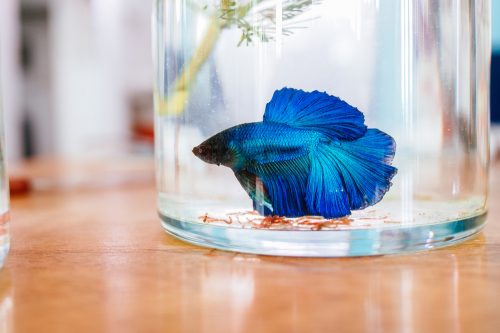
Fish are often “seen as low-maintenance pets” until people realize just how much work needs to be put into them, says Christopher Adams, founder of ModestFish. However, that’s usually because they pick the wrong kinds of fish: If you’re looking for a low-maintenance fish, go betta.
“Betta fish are stunning, really hardy, and you can have an awesome low-maintenance setup,” Adams says. He recommends buying a five-gallon aquarium kit, which is a perfect size for betta fish. “And once your tank is ready, you only need to feed them once a day—or get an automatic fish feeder—and replace 15 percent of the water each week.”
2. Guinea Pig
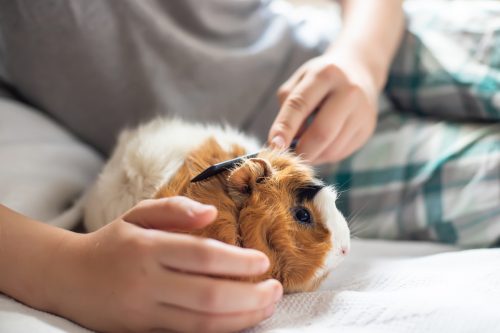
You don’t have to settle on a tank-living, aquatic animal just because you want a low-maintenance pet. If you’d still like something cute and cuddly you can hold, consider a guinea pig.
Laurie Hess, DVM, exotic animal veterinarian at Chewy, says guinea pigs make great first pets, as they are small, social, good with children, and “like a consistent schedule for feeding, playtime, and sleeping each day.”
They also have a plant-based diet that’s easy to maintain. “They enjoy a range of foods, including timothy hay, food pellets, vegetables, fruits, and an occasional treat,” Hess notes.
She does point out a few caveats with guinea pigs, however. “They should live in temperatures no greater than 80°F, they enjoy living in same-sex pairs if they are raised together (otherwise should be housed separately), and habitats should never be kept in direct sunlight or in a drafty area.”
3. Hamster
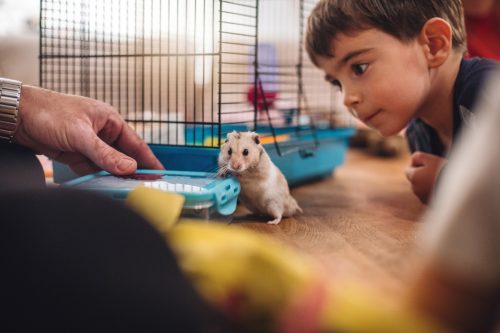
Another common cuddly, kid-friendly pet is a hamster. For the most part, hamsters do well on their own. According to PetMD, all they need is a cage, fresh water (which can be distributed with a drinking bottle on the side of the cage), hamster food (alongside small pieces of fruits and veggies), and a wheel for them to play and exercise on.
This may also be a great pet if you’re not home much during the day, as they’re nocturnal animals and should be fed at night. However, as Hess cautions: “If you’re a light sleeper, a hamster may not be best for you, as they often spend nights eating and running on their exercise wheels.”
Hess says hamsters typically live for two to three years, whereas guinea pigs average eight years.
4. Pug

Let’s face it, dogs aren’t ever really low-maintenance. They need a lot of love, attention, and affection. But if you do want to bring a precious pooch into your family, JP, owner of beloved Instagram pug Aji, says that pugs are one of the easiest dog breeds to own.
“We’ve never taken him into a dog groomer. His short hair doesn’t need any trimming,” JP says. “And the truth is, we only walk him about 30 minutes a day, and play fetch or tug of war for about 10 minutes, and that’s enough to keep him in shape.” Plus, their small size makes them great for apartments.
5. British Shorthair Cat
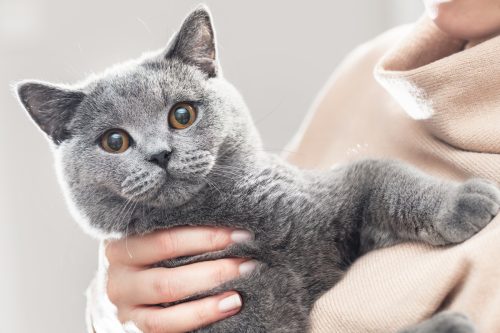
If you’re not ready to give up your dreams of having a cat, consider a more low-maintenance breed like a British Shorthair.
“This breed of cat is known for their calm and friendly personality,” says Patrik Holmboe, head veterinarian for Cooper Pet Care. “They often love human company and enjoy curling up on a lap. Think of a cat-version of a Labrador Retriever!”
And according to Daily Paws, unlike long-haired cats, “their short, soft, dense coat only requires weekly brushing to remove dead hair and skin cells.”
6. Rabbit

If you want a cute, cuddly pet, but aren’t ready to commit to a pup, consider a rabbit instead. Gilles Ventejol, founder of Animal Patient, recommends rabbits as a pet owner, despite being a specialist in cat and dog health.
“I got a dwarf rabbit upon the insistent and repeated requests of my children to have an animal,” he says. “I must say I’m quite pleased with the rabbit. She lives free in the flat and reaches her cage for drinking, relieving herself, or sleeping… But at the same time, she is quite funny, curious, and very interested when something new happens at home.”
Ventejol also says his expenditures are minimal as a rabbit owner. “She eats basically hay and stale bread with sometimes a carrot or an apple.”
7. Turtle

There are plenty of types of turtles out there to consider for a pet—approximately 270 to be exact, according to PetMD. Consider a smaller turtle that grows up to nine or twelve inches at most, like a painted turtle, if you’re looking for the kind you can put in a regular-sized terrarium.
In terms of diet, turtles are easy, as they only need to be fed four to five times a week, and most turtles generally eat insects, fish, and dark, leafy greens. The key to taking good care of a turtle is maintaining water temperature, keeping clean water, and feeding them consistently—which isn’t a lot of work in terms of keeping pets.
But one thing to note is that turtles can live for a while. For instance, a painted turtle can live up to 30 years.
8. Hermann’s Tortoise
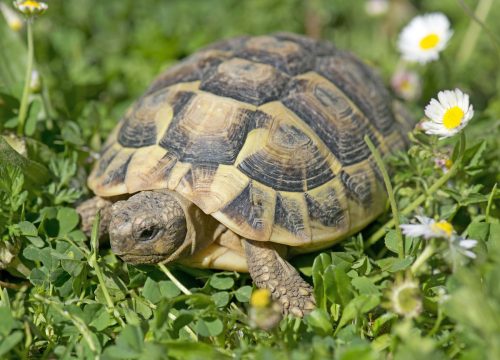
If you’re really looking for a long-term pet, Hermann’s Tortoises can live up to 50 years! These medium-sized tortoises grow to between six and 10 inches and are “usually pretty easy-going and gentle,” Hess says, though she does note that they “may bite if they feel stressed or threatened.”
Overall, though, Hermann’s Tortoises are incredibly low-maintenance pets. “You essentially just need to make sure they have a habitat, food, water, UV light and let them roam around and explore on their terms,” Hess says. They don’t really like being picked up, so you won’t have to feel guilty if you’ve not had time for socialization.
Once you have their home set up, you can buy food for these pets when you do your own grocery shopping. In addition to hay, they mostly eat “vegetables like Romaine or red/green lettuce, escarole, endive, collard/dandelion/mustard/turnip greens, prickly pear cactus pads, and kale,” according to Hess.
9. Hermit Crabs
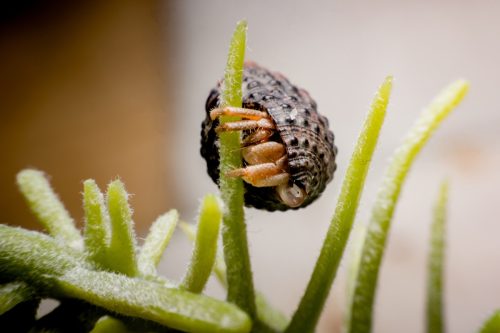
If the lifespan of a turtle intimidates you, go with a hermit crab instead! Hess says these crustaceans live for about 10 years if cared for properly. And like hamsters, they are nocturnal and should be fed at night.
Their diet consists of “commercial hermit crab [food], fruit, vegetables, nuts, and brine shrimp,” according to Hess, as well as “a calcium supplement to help keep their exoskeleton healthy.”
You may want to consider getting more than one hermit crab, though, as Hess notes they do best in groups of two or more. Just be sure to introduce them to each other gradually. If they fight, separate them, she says.
Their tanks are also very low-maintenance. Hess advises owners to line the bottom of their tank “with a layer of substrate (commercially available sand and coconut fiber bedding) that is deep enough to protect a hermit crab’s delicate body while they dig, burrow, and molt.”
And speaking of molting, hermit crabs will remain buried for four to eight weeks during this process. It’s completely normal, but “make sure not to pick them up as it can lead to fatal injury,” Hess cautions.
10. Sea-Monkeys
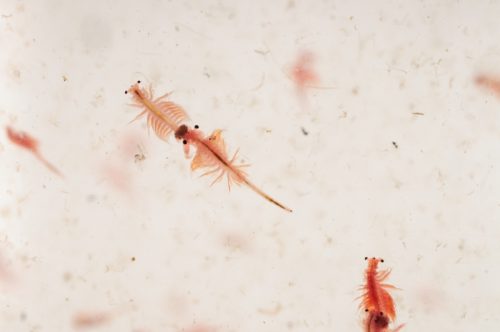
If turtles and hermit crabs aren’t your vibe, consider an even more low-maintenance aquatic animal: Sea-Monkeys! According to the official website for this creature, “They are virtually maintenance free pets.”
The site explains how their eggs are freeze-dried, so all you have to do is buy a packet from a vendor, fill a glass tank or container with room temperature water, aerate the water, pour in a water purifier (which will likely come with your order), let sit for 24 hours, and then pour in the eggs.
After that, all you’ll need to do is keep the tank in a shaded spot, add a scoop of food once a week, and add fresh water when needed.
11. Snail
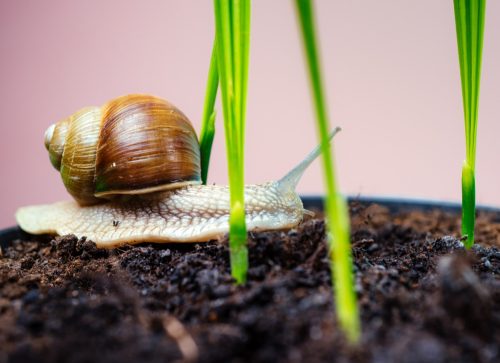
Can you imagine an easier pet to care for than a snail? For the most part, it’s a pet you observe (no need for daily walks or playtime!).
Snails should be kept in a clear terrarium, and you can house multiple snails together, with one to two inches of soil, according to Pets on Mom.
Their diet consists of small bits of apples, carrots, and cucumbers with chalk, egg shells, or cuttlefish bone for calcium to “strengthen your snails’ shells.” Other than that, you just need to clean your snails’ terrarium at least once a week, spraying the walls with water and paper towels to clear mucus trails. Simple!
12. Dwarf Frog
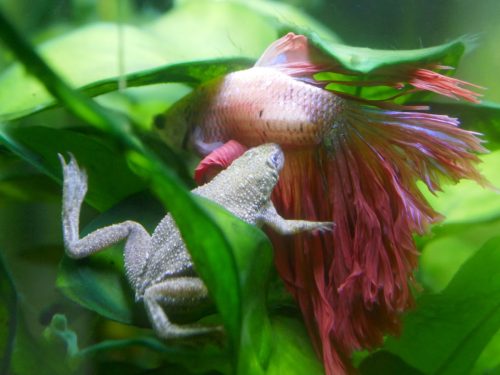
Still on the search for the perfect small amphibian? The African dwarf frog may be the pet for you! They only grow an average of one-and-a-half inches and live up to five years, according to the pros at Petco.
In terms of food, their diet consists of bloodworms, brine shrimp, and frozen mysis shrimp. They live in an aquarium, where the water quality should be checked at least once a week and changed every two to four weeks.
As a bonus, dwarf frogs can live harmoniously with docile fish—like a betta—if you want more than one kind of pet.
13. Ants
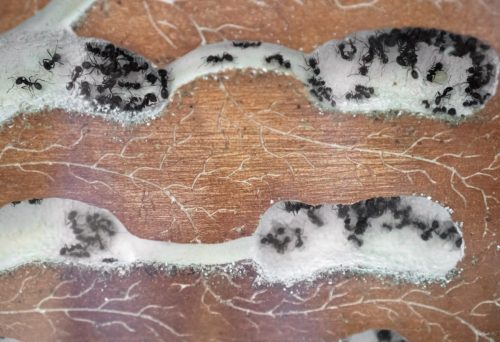
Keeping ants is a fun and interesting way for young children to feel like they “own pets,” without parents having to spend a lot of time “taking care” of said pets.
With an ant farm (there are many starter kits you can purchase online), the ants do most of the work. According to Ant Keepers, your common ants do best at room temperature and their diet consists of sugar water or honey water and possibly small pieces of fruit like apples or pears.
Do be careful not to move the ant farm once the ants have built their tunnels, as it might cause a collapse, which could kill or injure the ants.
14. Budgerigar
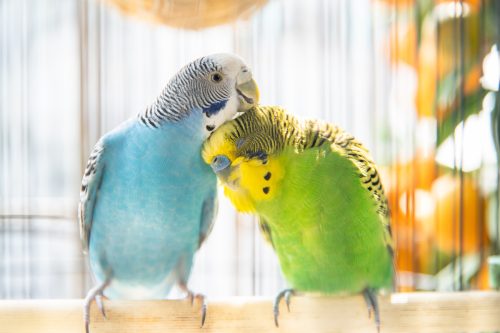
Budgerigars are members of the parakeet family. These super sociable birds, also known as budgies, are lovely low-maintenance pets if you’d like someone to “talk” to.
“They frequently learn behaviors and mimic voices and tones, and, with practice, some parakeets have been known to learn vocabularies of more than 100 words,” Matthew McCarthy, DVM, a veterinarian and founder of Juniper Valley Animal Hospital in Queens, New York, previously told Best Life.
And according to PetMD, “they are not as loud as many other parrot species,” and they don’t require much to be happy—a cage with perches, a UV light, and some bird toys. McCarthy says you’ll need to put out water and food once a day and clean their cage once a week.
15. Rat
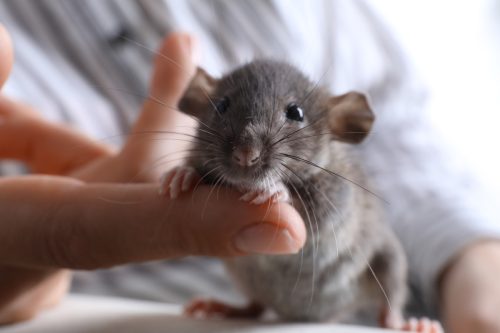
Hamsters aren’t the only easy-to-care-for rodents you can consider for your home. While the idea of rats draws forth troubling images of sewers and dark corners, they’re anything but dirty animals.
As Laurie Hess, DVM, explained on Vet Street, they actually groom themselves and organize their food into neat piles, making them one of the cleanest pets you can own.
Norway rats are the most common species of pet rat, as they only grow nine to eleven inches long. McCarthy previously told Best Life that they prefer to be kept in same-sex pairs or groups and that they only really require a cage and daily food and water.
16. Chinchilla
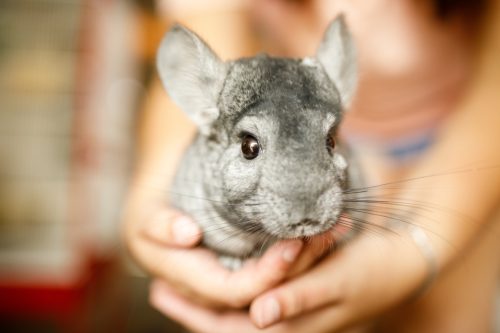
Perhaps the cutest rodent you can own is the chinchilla. These adorable creatures are “known for their high energy and soft fur,” says Hess.
According to The Spruce Pets, chinchillas actually prefer not to be held that much, so if you’re looking for a pet you can keep at arm’s length but still love, this may be the one for you.
Like most rodents, they need a large, active cage lined with lots of Timothy hay. They also need a shallow dish of bathing sand. “Chinchillas need to take dust baths at least 4-5 times a week to remove oil and dirt from their fur and to keep their coats clean,” Hess explains, which means you won’t have to worry about bathing them.
They do require a diet of chinchilla-specific food, which can be bought at a local pet store, along with some vegetables and high-fiber fruits, according to Hess.
You’ll also want to note that chinchillas love to jump and climb, so they will need a safe space to get exercise outside of their cage.
17. Tarantula
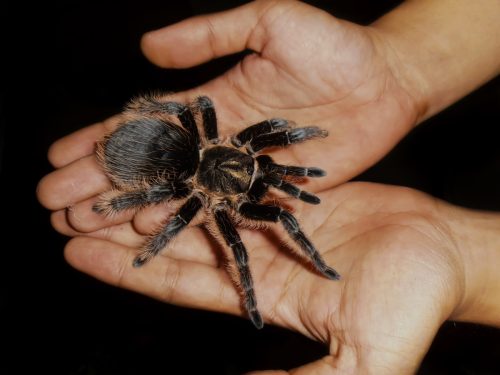
If you’re not against keeping spiders as pets, a tarantula might be a good addition to your family. Male tarantulas grow from two to 10 inches, and most species only live up to seven years, according to the experts at Petco.
Tarantulas just need a suitable terrarium to roam around in, and they eat live insects like crickets, mealworms, super worms, and roaches.
The one thing to remember about these creatures is that they need to be kept in a dark part of your room, away from sunlight.
18. Scorpion
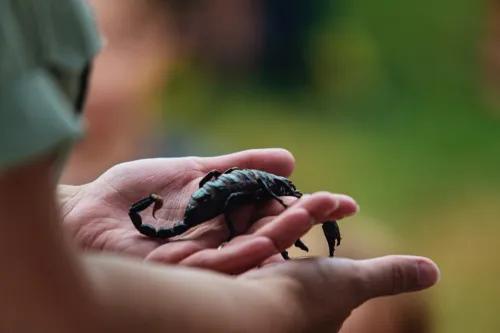
If you’re into creepy crawlies, you may consider a pet scorpion. This creature only grows three to eight inches and lives anywhere from two to six years, according to Petco.
With an adult scorpion, you only have to feed it every other day, and its diet consists of insects like crickets, small mealworms, and wax worms.
The one thing you need to keep in mind about scorpions is the temperature of their environment. Unlike other animals, scorpions need a hotter tank—anywhere from 80 degrees Fahrenheit at the coolest to 90 degrees at the warmest.
19. Leopard Gecko
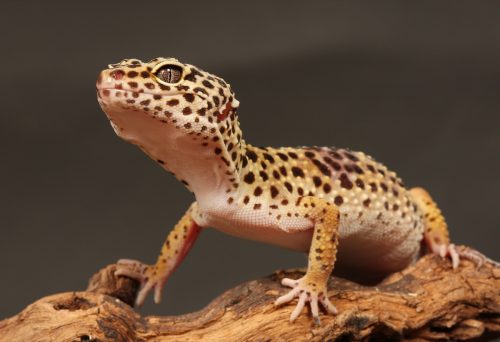
If you’re thinking of bringing a reptile into your home, leopard geckos are great for beginners, according to Hess, as they are “sociable and easy to handle” and have a gentle disposition.
They also don’t need a lot in terms of care. According to The Spruce Pets, a 15- to 20-gallon tank can easily hold two to three leopard geckos, and they have a normal diet of crickets, wax worms, and mealworms.
Not only that, but as Hess explains, they are crepuscular (most active at dawn and dusk), “so they will often hide under rocks or burrow under substrate during the day”—making them another low-maintenance option if you have a busy schedule.
20. Corn Snake
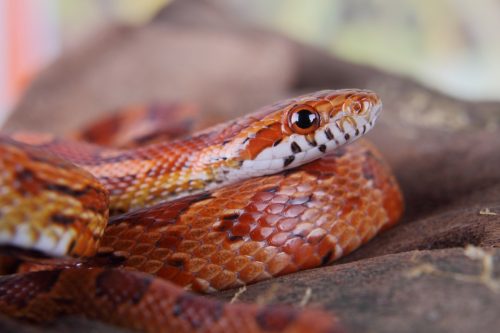
Snakes are not everybody’s cup of tea, but they are an easy-to-care-for pet. According to John Virata of Reptiles magazine, good beginner pet snakes include the corn snake, California kingsnake, rosy boa, gopher snake, and ball python.
The most popular is probably the corn snake because they’re fairly docile and don’t grow that large—two to five feet in length at most. In terms of diet, corn snakes primarily eat rodents and can also find a tasty treat within a quail egg.